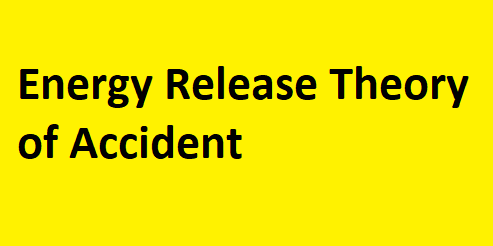Energy Release Theory:
Dr. Lestie Ball, former Director of Safety for NASA, introduced a causation theory. His thesis is that all accidents are caused by hazard, and all hazards involve energy, either due to involvement with destructive energy sources or due to a lack of critical energy needs. This model is most useful to identify hazards and to understand system safety.
CLICK HERE FOR 
Gibson noted that injury to a living organism can be only by some energy interchange. Hence it was suggested that the energy exchange should be considered as the injury agent. The energy exchange resulting in an injury could be mechanical, chemical, thermal, electrical etc. This concept is useful in understanding the way injury is caused and examining the solutions. When a grinding wheel is in stop position it does not make an accident, but if it runs and fingers trapped, it makes accident because of its kinetic energy.
William Hadden, in 1970, explained transfer or release’ as the main factor for accident causation and said that accidents and injury caused because of transfer or release of energy b objects, event or environment interacting with Ten strategies were suggested by Had prevent or reduce losses as under:
CLICK HERE FOR ? HIERARCHY OF CONTROL
- Prevent the transfer or origin of energy. e. Substitution – using toluene instead of Ix not keeping the car running, dipping ins spraying, shot blasting instead of san b.
- Reduce the amount of energy transfer. i.t vehicle or machine at slow speed, quantity or concentration of hazardous chemicals.
- Prevent release of energy. e.g. flameproof fitting in the flammable area, fall arrestor dike to stop the spread of chemical, safe o’ pipe or level cut off the device.
- Change the rate of release or distribution released energy. e.g. reduce the road slope, use an inhibitor to reduce the rate of reaction, sprinkler reduce the rate of burning, a scrubber to scrub toxic gas, a condenser to liquefy organic vapor.
- Divert (separate) the energy released in space e.g. separate path for vehicle-pedestrian traffic, keep electric wiring or pesticide out of reach, and discharge gases at height.
- Provide a barrier between the energy released a structure or a person likely to be affected guards on machines, radiation shield safety goggles, earplugs, insulation surface, blast wall against explosion energy.
- Mark the surfaces of the structure safe. E.g. r c corners, blunt objects, big handles of to no sharp edges.
- Strengthen the structure or person susceptible damage. e.g. fire-resistant wall, training workers and vaccination for the disease.
- Early detection of damage and actuate effect. e.g. fire detectors with sprinkle level alarm and tripping of feed temperature alarm and starting of the system.
- Speedy measures to restore normal condition rehabilitation of injured worker, repair damage machine or vehicle.
CLICK HERE FOR ? SWL AND SAFETY FACTOR






Nice Information,further going- i am doing RCA of Methylene Chloride,we received a drum in bulged condition
BP is 39deg c and Flash point is not applicable, Vapour pressure:at 79.99 kPa (35 °C)[3,FIRST I want to understand is methlyene chloride flammable or not because the confusion is in msds it shows NFPA F=1 ,i checked many msds from net also,
Methylene chloride is a combustible liquid, but its vapor is flammable only when present in relatively high concentrations (14% to 22% in air).